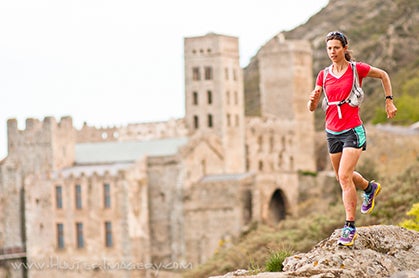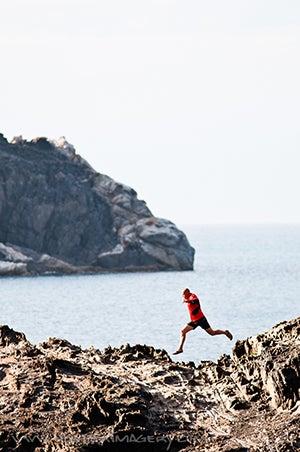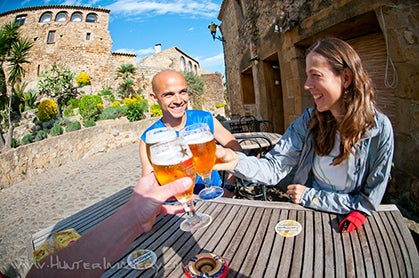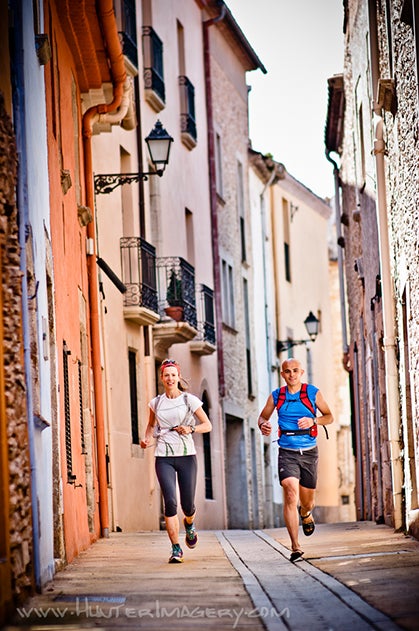New perk! Get after it with local recommendations just for you. Discover nearby events, routes out your door, and hidden gems when you sign up for the Local Running Drop.
A trail-running tour of Spain’s Costa Brava region yields an unexpected immersion in Catolonian gastronomy, culture and history.

Photo by Chris Hunter
{vimeo}47044446{/vimeo}
Our guide from Running Costa Brava Tours, Pablo Rodriguez, is easily recognizable in the Girona’s bustling train terminal. Not because I’ve met him before or seen his photo; rather, I recognize him in the way a runner recognizes another runner.
Pablo is wearing a crimson hydration vest over a well-worn, sweat-stained technical T-shirt with grey shorts, his sockless feet in pancake-flat yellow running shoes that scream running geek. His bald head shines as brightly as his eyes when we make visual contact. He bounds towards me, deer-like, with a light and springy gait. “Welcome to Catalunya!” he says.
Photographer Chris Hunter and I are spending the next four days with Pablo for a fully supported Catalonia trail-running tour of Costa Brava’s ancient villages, spas and wineries between Girona and the French boarder at the Pyrenees. We’d spent the previous day in Barcelona, exploring the famous city’s La Rambla tourist district and famous Goudi landmarks. After a night in the city, we hopped an early morning train northeast to Girona, where our tour would begin.
During the hour-long drive to the trailhead the conversation gravitates to running. “Running is not just a sport; it’s as natural as breathing,” says Pablo, who gave up shoes and began running in Tarahumara-inspired Luna sandals after reading the bestselling book Born to Run. “Humans don’t really need anything between their feet and the ground. Running without shoes is a matter of softness.”
Then he asks if we’ve heard of Kilian Jornet, arguably the most talented young trail runner on the planet.
“He’s Catalonian, you know,” Pablo says proudly.
While Catalonia (Catalunya in Catalan) is under Spanish rule, Pablo explains that it is an autonomous region with a proudly distinct culture, defined largely by its cuisine and language. All locals speak Catalan, which was banned until just 37 years ago but now appears on all the region’s road signs.
“How long has it been since Catalonia was a country?” I ask.
“Not long, about 300 years,” says Pablo. I snicker, then realize that, to Catalonians, 300 years isn’t a long time. “Someday we will again be our own nation.”
Pablo turns off the highway onto a country road that winds through green pastures and vast sunflower fields. Then we turn onto a barely passable, rocky dirt road that weaves uphill through forests of cork trees from which the bark has been stripped to make bottle corks.
As we near the trailhead, I ask Pablo who maintains the trail system. “Some I made myself using the paths forged by wild boars, but they are low to the ground so I must clear the way for people using my machete,” he says.
“I gotta see that,” chirps Chris from the back seat.
“Wild boars?” I quiver.
“Yes, but not to worry,” assures Pablo. “They are harmless.”

Photo by Chris Hunter
We pile out of the car at a centuries-old stone church in a grassy meadow. Trails disappear into the forest in all directions. We are miles from the nearest town so I can only surmise that the faithful walk these trails to attend mass. The scent of salty sea air spurs me to action. “C’mon, let’s go!” I yell to Chris, who carefully loads his camera gear into a lightweight hydration pack he had bought especially for this trip. Chris, who lives in the adventure-sport hub of Moab, Utah, typically shoots photos of skydivers and BASE jumpers, but luckily, he saw the opportunity to spend a week running and shooting photos in Spain as equally thrilling.
Pablo points us to one of the trailheads and hands me a GPS unit by which we will navigate the day’s 23-kilometer route. He waves goodbye as he starts the car to drive around the hillside to meet us at our next rendezvous point.
Forty-five minutes later, we emerge from a dirt road surrounded by head-high shrubbery onto a sandy knoll shaded by trees bending in the relentless south winds, where Pablo stood waiting. The three of us hop off the knoll and run along the white-sand beach, passing in front of a dozen wooden boat houses, each one’s door painted a vibrant red, green, blue or yellow. As essential to coastal life in Costa Brava as car garages in America, these coveted boat shelters are never bought or sold, but are passed on from one generation to the next.
The trail contours the cliff tops above the pounding sea, changing from soft to crude stone steps that ascend and descend the rocky shoreline. Soon we hit the smooth, gentle Cami de Ronda, which leads to the glistening whitewashed, red-tile-roofed villas of Llafranc, which Pablo describes as a “simple” fishing village. Yet a row of gourmet restaurants and upscale boutiques line its beachfront promenade.
The moment we step onto Llafranc’s cobblestone streets, dark storm clouds overhead release a deluge. We duck into an empty restaurant for beers and pa amb tomata, a Catalonian open-faced sandwich made by rubbing a juicy, red tomato half onto a piece of fresh, crusty bread then draping it with cured meat slices.
“Here, please take my rain shell,” Chris offers.
Pablo, wearing only running shorts and T-shirt, waves away the jacket in Chris’s hand.
“No, the human body is made for self regulation. I’ll see you in an hour,” he says, dashing barefoot through the hammering rain to fetch the car.
The next morning, I awake to the feeling of intense heat on my face and open my eyes to the sun-filled room at El Far, which, before being a hotel, was an 18th-century monastery.
I slip on a fuzzy terrycloth robe, open the narrow French doors and step onto the balcony of our cliff-top accommodations. Leaning on the wrought-iron railing, I listen to the gentle sound of waves crashing onto the rocks far below. To the right is Sant Sebasti de la Guarda lighthouse overlooking the street where we’d dined the night before on richly seasoned seafood-and-rice paella at Llevant restaurant. To the north is an unobstructed view of the rocky shoreline that is the site of today’s 22-kilometer run.
I descend the grand stone staircase that for centuries was traveled only by monks and take a seat in the solarium for breakfast. Doing my best to avoid over-indulging on rich cheeses and cured meats, I opt instead for the fresh fruit, creamy, unsweetened yogurt and fresh-squeezed orange juice.
We start running at 11 a.m., with Pablo leading us along well-worn seaside paths connecting a series of pebble-beached coves. We greet hiking couples and beach-going families with the Catalonian phrase, “Bon dia!” as we pass.
Nearing the marine village of Tamariu, Pablo tells us about his family life with his wife, Cristina, juggling two jobs and living with four active sons under the age of eight when he suddenly stops and turns to face us, a serious expression on his face. “I may not be the boss at home, but here I am the boss,” he says. “Follow me!”

Photo by Chris Hunter
I hesitate, wondering what he has in store. Pablo veers off the trail and hops wildly from boulder to boulder next to the water. Without breaking stride, he flicks off his sandals, yanks off his top and sprints off the end of a wooden diving board, hitting the water with a sploosh.
By now I know Pablo well enough to know he won’t let me off the hook. Reluctantly I remove my pack and unlace my shoes. My hyper-efficient tendencies—which serve me well in ultramarathons—kick in and I feel slightly annoyed with the delay. After all, we’d only covered a few miles and many more remain. As I stand there contemplating, Chris sprints past me and enthusiastically takes the leap. But my clothes will get soaked and I’ll have to change and reapply sunscreen and we still have a long way to go …
The shock of plunging into the frigid sea is the face slap I deserve. Hauling myself onto the rocks with water streaming from my clothes, I laugh at my uptightness. Remember, Elinor, you’re on vacation; there is no schedule, no objective.
After changing into dry clothes at the car, Chris and I follow the GPS’s arrow pointing us inland. We miss the ocean’s cool breeze and sweat under the sun’s rays. Our feet sink into the sandy trail that takes us through a tree plantation. As we gain elevation, it turns to firm doubletrack surrounded by natural forest. After cresting the hilltop, we rocket down the other side until we reach a pancake-flat road leading us to the medieval city of Pals.
Traversing the ancient stone fortifications encircling Pals—reputedly Christopher Columbus’ port of departure—cars and paved roads are replaced with pedestrians and narrow cobblestone streets. Being in Pals feels like visiting another era. At the center of its beautifully restored Gothic Quarter is a 13th-century Romanesque tower called Torre de les Hores, from where sentries would scan the horizon for pirates and other invaders.
It’s all we can do to keep up with Pablo as he darts along streets so narrow my outstretched hands touch the buildings on either side. He abruptly halts in front of a small wooden door and motions us to sit at one of the three slim metal tables out front.
“We’re here!” he declares.
Chris and I glance at one another, wondering what “here” means.
“Our run is done for today; now it’s time for beer!”
We cheer and step through the small doorway into a room barely wide enough for a bar and a row of bar stools. We order three Estrella Damm Catalonian pilsners and take a seat outside in the warm sunshine.
Before long, Pablo reminds us that the day is not over; we have a spa appointment. A short drive takes us to Mas de Torrent, a luxury hotel of the prestigious Relais & Château Group. We walk through the hotel’s manicured landscape to Mas Spa, a zen-inspired ultra-modern spa tucked into a lush garden. For the next two hours, hot-water jets massage my tired muscles, an ice-cold plunge pool flushes the soreness from my joints and rosemary-infused bath products refresh my senses.
Later that evening we drive to Mas Camangau hotel in the nearby town of Begur, and the owner, Miguel, greets us like old friends. His grey-streaked hair is pulled back into a short ponytail and his jovial face sports cheeks as round as his eyeglasses. Grey stone archways frame the entrance to each room of the 200-year-old-farmhouse-turned-boutique hotel, giving it a cozy yet regal ambiance.
Miguel leads us out a back door and down more steps into a garden patio. “Your room is in the back where the horses were kept,” Miguel says with a chuckle. The old barn-wood door with iron fixtures opens to a charming room with a vaulted ceiling and modern amenities.
At what is normally my bedtime, Chris and I take our seats in the hotel’s restaurant, where Miguel announces that he has arranged a special tasting menu for us. The first delicious bite of salmon ceviche served with vichyssoise sets the tone for what is a five-course feast of Catalonian delicacies. Between gulps of local red wine we savor bites of hand-made aubergine ravioli served with mussels and rosemary, then delicate fish filets on a tomato purée topped with olive tapenade and chives, followed by thinly sliced roasted duck topped with a sweet sauce made with strawberries, raspberries and sherry.
Every dish includes local ingredients and some personal connection to Miguel or his family.
“The father of the wife of my brother grows this melon,” Miguel explains with pride when our server delivers two pieces of bisbalen, a Catalonian melon-jam-filled pastry dusted with powdered sugar. “And it tastes even better with this,” he says, pouring a sweet-smelling, clear liqueur into a couple of shot glasses.
“Oh, no, none for me!” I say, thinking ahead to tomorrow’s run.
“Well, I can’t say no,” says Chris as Miguel fills his glass for a second time.

Photo by Chris Hunter
The next morning we drive to Figueres, the first large town we’ve encountered since departing Girona, to visit the Teatre-Museu Dali, a museum dedicated to Salvador Dali’s surreal art work. A true Catalonian, Dali’s love of fine food influenced his art in unexpected ways, his favorite foods appearing in sculptures and paintings.
After an hour of roaming the museum’s crowded, narrow hallways like livestock in a cattle chute, we’re ready to escape the tourist trap and begin our 29-kilometer run through the wild landscape of National Parc Cap de Creus from the town of Llança to Cadaqués.
Pablo drops us off at the base of Coll Perer’s rocky, wind-scoured hillside where only hardy scrub grows. Then he points to a ridge line high above us.
“Follow the ridge around to the right to Verdera Mountain and eventually you’ll see the monastery,” he says.
With heads down and arms pumping, we ascend 1500 feet over the next hour and a half to eventually stand before the enormous Sant Pere de Rodes, a former Benedictine monastery dating back to 878. Chris, who had been sluggish on the climb due to last night’s digestif, perks up at the sight of the monastery’s grandeur. “This place is killer for photos!” says Chris, darting around to scout the best shooting angles.
Running up to the monastery’s massive stone walls, we crane our necks to gaze at the bell tower rising from its center. Laying my palm on the cool stone, I close my eyes and savor the serenity conjured by this place’s sacredness.
I soon forget my disappointment that we don’t have time to pay the small entrance fee and tour the interior when we begin a treacherous mile-and-a-half, straight-downhill sprint to Santa Creus.
Turning south, we follow the coastline for 20 kilometers, passing through Port de la Selva en route to Cadequés, where would be stopping for the night. I am grateful for the mindless ease of following the gently rolling trail through olive-tree orchards, meadows and past Salvador Dali’s former residence (easily identifiable for the giant egg adorning the roof). As we reach the Cap de Creus headland, the orchards give way to a barren landscape of razor-sharp fins of black stone reminiscent of Hawaiian lava fields. From this easternmost tip of the Iberian Peninsula, we watch the iron-grey rain clouds crowd out the sun’s final rays.
That evening, we meet Pablo for dinner under the awning at restaurant Can Rafa just as a thunderstorm releases its fury. It’s prime dinner hour and yet the streets and restaurants are deserted.
Suddenly, boisterous cheers from an unseen crowd pierce the silence.
“It’s the game,” says Pablo. “Everyone is in the bars watching the Barcelona versus Madrid futbol match. Sounds like Barcelona just scored.”
These days, Spanish versus Catalan political clashes are settled on the soccer field rather than the battle field. Catalonians (represented by team Barcelona) are lobbying for independence from Spain (represented by team Madrid). While separatist political parties exist, they so far lack enough clout within the Spanish political system to achieve independence.
Shortly after the game ends, with Barcelona’s defeat, the streets fill with despondent fans. Then everything goes dark, an apparent power failure due to the thunderstorm. “It’s those bastards in Madrid!” a passerby yells from the darkness. Our fellow diners shout back in agreement and shake a fist, swearing to get them next time.
The game is quickly forgotten when dinner arrives. We devour platter after platter of locally caught tallarines and berberexos (varieties of mussels) swimming in olive oil and fresh-ground pepper, followed by erisos (sea urchins), gambitias (grilled prawns served with head and shell on) and whole anchovies served on rounds of seasoned crustini.
I swear I have no room in my belly for another bite of food when dessert appears.
“It’s not about eating; it’s about pleasure,” says Pablo. He’s right, I say to myself as I dip a spoon into the fluffy, caramel-encrusted apple mousse.
After spending the night in Cadequés, Chris, Pablo and I head to the Cellar Martín Faxió winery, at the behest of Rafel Martín Faxió, our server at dinner last night at Can Rafa, whose parents own both the winery and restaurant.
Rafel greets us with the same warmth we’d experienced the previous evening.
“Everything is done by hand, even putting the labels on the bottles,” he says, walking us past the rows of wooden wine barrels. Rafel’s father, Rafa Martín Mota, motions for us sit in a cozy, cave-like room next to a wood-burning fireplace. On a small wooden table are glasses of full-bodied red wine and plates of cheeses and paper-thin pork slices that melt in my mouth.
By noon, we’re driving back to Girona to begin our final run stage, starting with a four-mile jaunt uphill through the Gavarres Forest following the Torre Gironella trail (and some of Pablo’s machete-cut trails) to the ruins of Castell de Sant Miquel that overlook the city. From our vantage point at 1300 feet above sea level, we survey the vast terrain we’d covered on foot over the preceding few days.
After returning by the same trail to Girona, Pablo takes us on a whirlwind running tour of Girona’s ancient, serpentine streets, landmarks and alleyways. “Just how old is Girona?” asks Chris.
“Well, these stones here were laid by the Romans in 75 BC,” says Pablo. “And that cathedral was originally built as a Zeus temple.”
“Pablo, what is your favorite part of doing these tours: the running, the food or the history lesson?” asks Chris. Pablo smiles and thoughtfully studies the layers of stone in the wall—each one laid by a different settler or conqueror over the past 2000 years—before voicing his response.
“I believe the only real way to experience a place is to run through it,” he says.
[ Example Week-long Itinerary ]
Day 1 From Barcelona, take the train to Girona. Run 17 kilometers, including a tour of the Girona’s historic city center and run to Sant Miquel Castle. Overnight at Legends Hotel.
Day 2 Run 23 kilometers from Fitor to Llafranc. Overnight at El Far hotel in Llafranc.
Day 3 Run 22 kilometers from Llafranc to the medieval city of Pals. Enjoy a treatment at Mas Spa. Overnight at Mas Camangau in Begur.
Day 4 Run 24 kilometers from l’Escala to Castello d’Empuries. Visit the Teatre-Museu Dali. Overnight at Castello d’Empuries.
Day 5 Run 23 kilometers from Roses up to the mountains via the Ruta del Dolmens to Cadaqués. Wine tasting at the Cellar Martín Faxió winery. Overnight at Hotel Rocamar.
Day 6 Run 29 kilometers from Cadequés to Port de la Selva through Cap de Crues National Park. Overnight at Port de la Selva.
Day 7 Run 20 kilometers from Port de la Selva to Sant Pere de Rodes Monastery to Portbou at the French border. Take the train back to Barcelona.
LOGISTICS:
GETTING THERE Fly to Barcelona. Tours begin and end in Girona. From Barcelona, take the Renfe regional train service to Girona (7.50 euros per person each way). www.renfe.com
WHEN TO GO Costa Brava is an ideal year-round trail-running destination, though you might want to avoid the tourism high season and go in spring or fall when temperatures are cool, sunshine is prevalent and beaches are uncrowded. Winter (December to February) is generally mild and rarely cold.
INFORMATION Running Costa Brava Tours (www.runningcostabrava.com) organizes custom running tours throughout Costa Brava. Owners Pablo and Cristina Rodriguez build custom itineraries with GPS-mapped running routes.
Package prices depend on the number of people in your group, quality of hotels, time of year (in July and August hotel rates average 20 percent higher than the low season), trip duration and your choice of additional activities (kayaking, spa, parasailing, museums, wine tasting, etc.). One-week packages in low season (October through March) begin at 752 euros per person (three-star hotels) and 914 euros per person (four-star hotels).
Packages include guided runs, hotel bookings, local ground transportation, luggage transfers, water stops, energy snacks, additional activities and restaurant reservations. Breakfasts are included with all hotel reservations.
{vimeo}47044446{/vimeo}